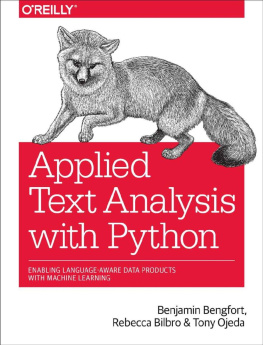Dipanjan Sarkar - Text Analytics with Python: A Practical Real-World Approach to Gaining Actionable Insights from Your Data
Here you can read online Dipanjan Sarkar - Text Analytics with Python: A Practical Real-World Approach to Gaining Actionable Insights from Your Data full text of the book (entire story) in english for free. Download pdf and epub, get meaning, cover and reviews about this ebook. year: 2016, publisher: Apress, genre: Children. Description of the work, (preface) as well as reviews are available. Best literature library LitArk.com created for fans of good reading and offers a wide selection of genres:
Romance novel
Science fiction
Adventure
Detective
Science
History
Home and family
Prose
Art
Politics
Computer
Non-fiction
Religion
Business
Children
Humor
Choose a favorite category and find really read worthwhile books. Enjoy immersion in the world of imagination, feel the emotions of the characters or learn something new for yourself, make an fascinating discovery.
- Book:Text Analytics with Python: A Practical Real-World Approach to Gaining Actionable Insights from Your Data
- Author:
- Publisher:Apress
- Genre:
- Year:2016
- Rating:3 / 5
- Favourites:Add to favourites
- Your mark:
Text Analytics with Python: A Practical Real-World Approach to Gaining Actionable Insights from Your Data: summary, description and annotation
We offer to read an annotation, description, summary or preface (depends on what the author of the book "Text Analytics with Python: A Practical Real-World Approach to Gaining Actionable Insights from Your Data" wrote himself). If you haven't found the necessary information about the book — write in the comments, we will try to find it.
Derive useful insights from your data using Python. Learn the techniques related to natural language processing and text analytics, and gain the skills to know which technique is best suited to solve a particular problem.
Text Analytics with Python teaches you both basic and advanced concepts, including text and language syntax, structure, semantics. You will focus on algorithms and techniques, such as text classification, clustering, topic modeling, and text summarization.
A structured and comprehensive approach is followed in this book so that readers with little or no experience do not find themselves overwhelmed. You will start with the basics of natural language and Python and move on to advanced analytical and machine learning concepts. You will look at each technique and algorithm with both a birds eye view to understand how it can be used as well as with a microscopic view to understand the mathematical concepts and to implement them to solve your own problems.
This book:
- Provides complete coverage of the major concepts and techniques of natural language processing (NLP) and text analytics
- Includes practical real-world examples of techniques for implementation, such as building a text classification system to categorize news articles, analyzing app or game reviews using topic modeling and text summarization, and clustering popular movie synopses and analyzing the sentiment of movie reviews
- Shows implementations based on Python and several popular open source libraries in NLP and text analytics, such as the natural language toolkit (nltk), gensim, scikit-learn, spaCy and Pattern
What you will learn:
Natural Language concepts
Analyzing Text syntax and structure
Text Classification
Text Clustering and Similarity analysis
Text Summarization
Semantic and Sentiment analysis
Readership :
The book is for IT professionals, analysts, developers, linguistic experts, data scientists, and anyone with a keen interest in linguistics, analytics, and generating insights from textual data.
Dipanjan Sarkar: author's other books
Who wrote Text Analytics with Python: A Practical Real-World Approach to Gaining Actionable Insights from Your Data? Find out the surname, the name of the author of the book and a list of all author's works by series.











![Bhargav Srinivasa-Desikan [Bhargav Srinivasa-Desikan] - Natural Language Processing and Computational Linguistics: A Practical Guide to Text Analysis With Python, Gensim, spaCy, and Keras](/uploads/posts/book/119021/thumbs/bhargav-srinivasa-desikan-bhargav.jpg)
